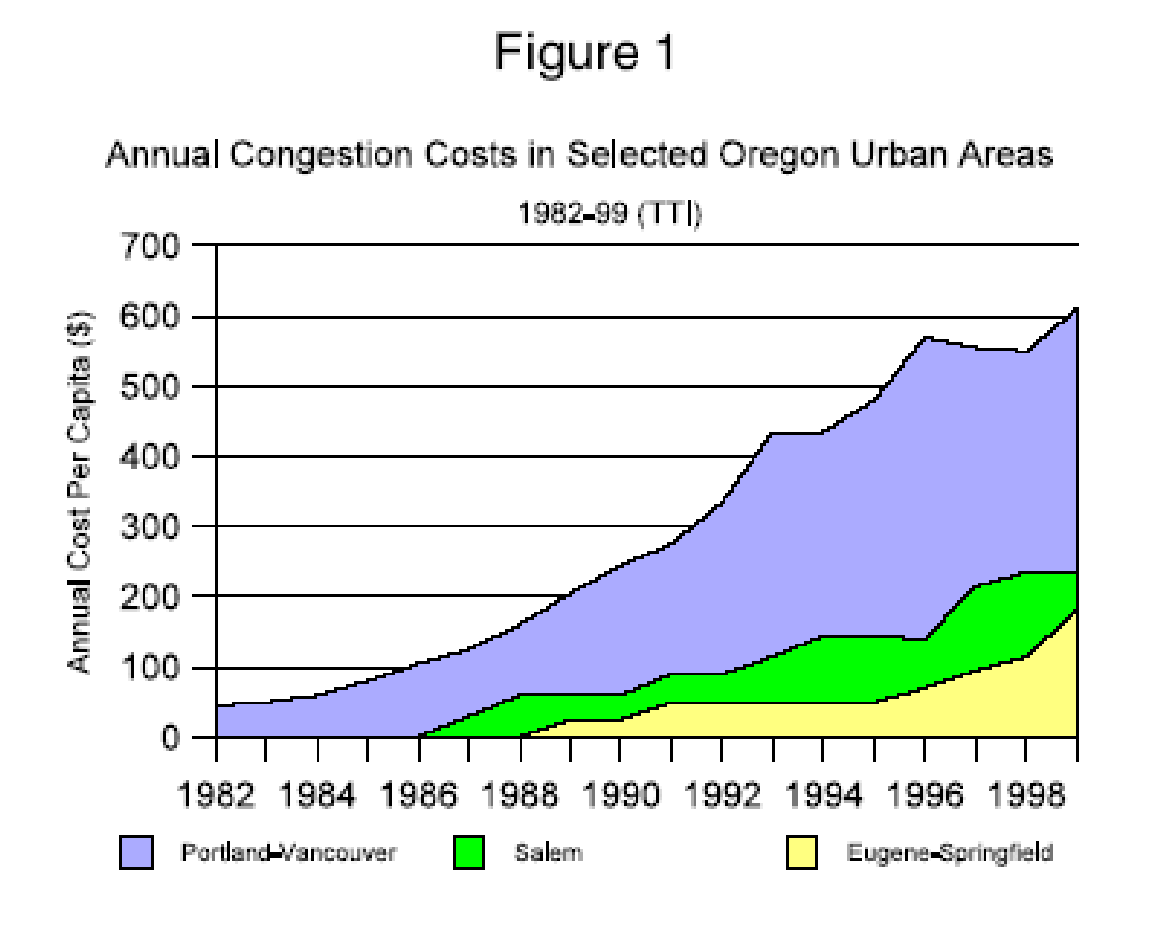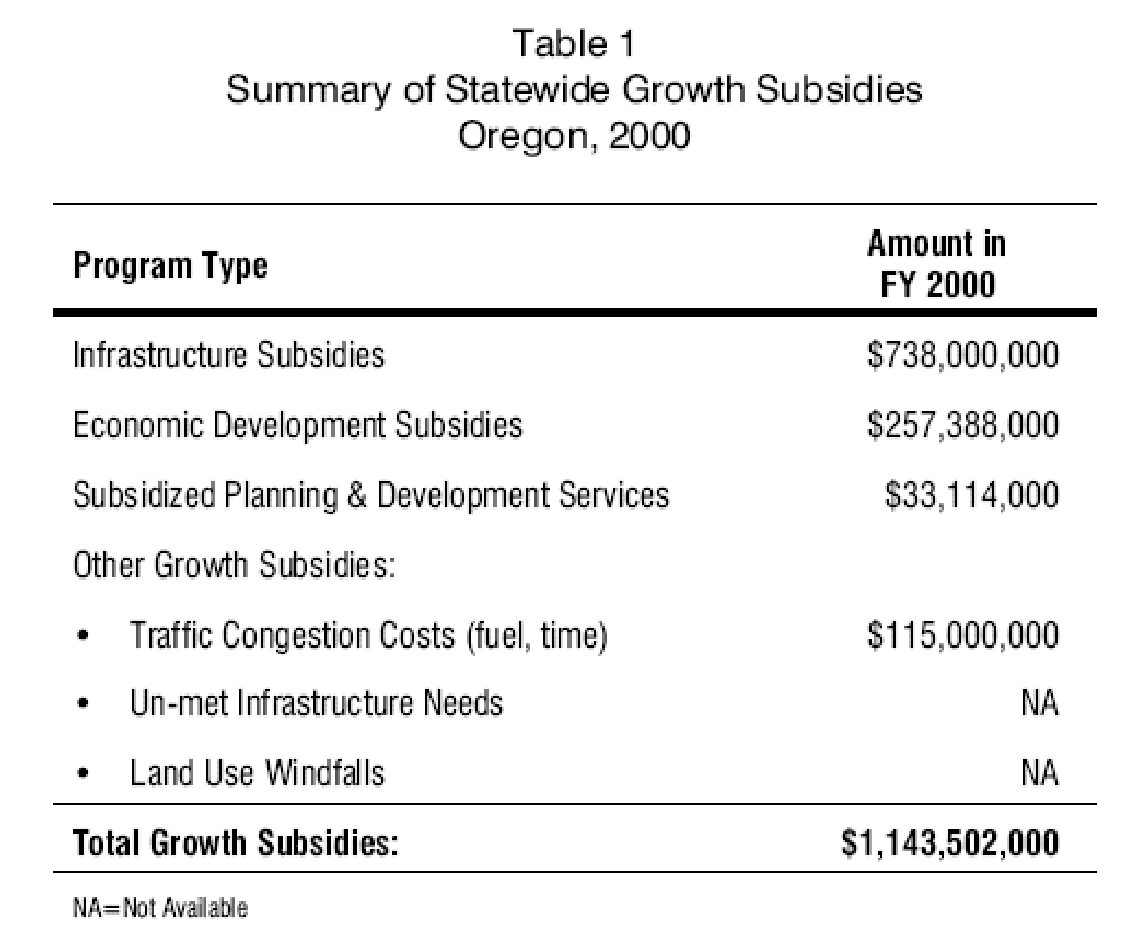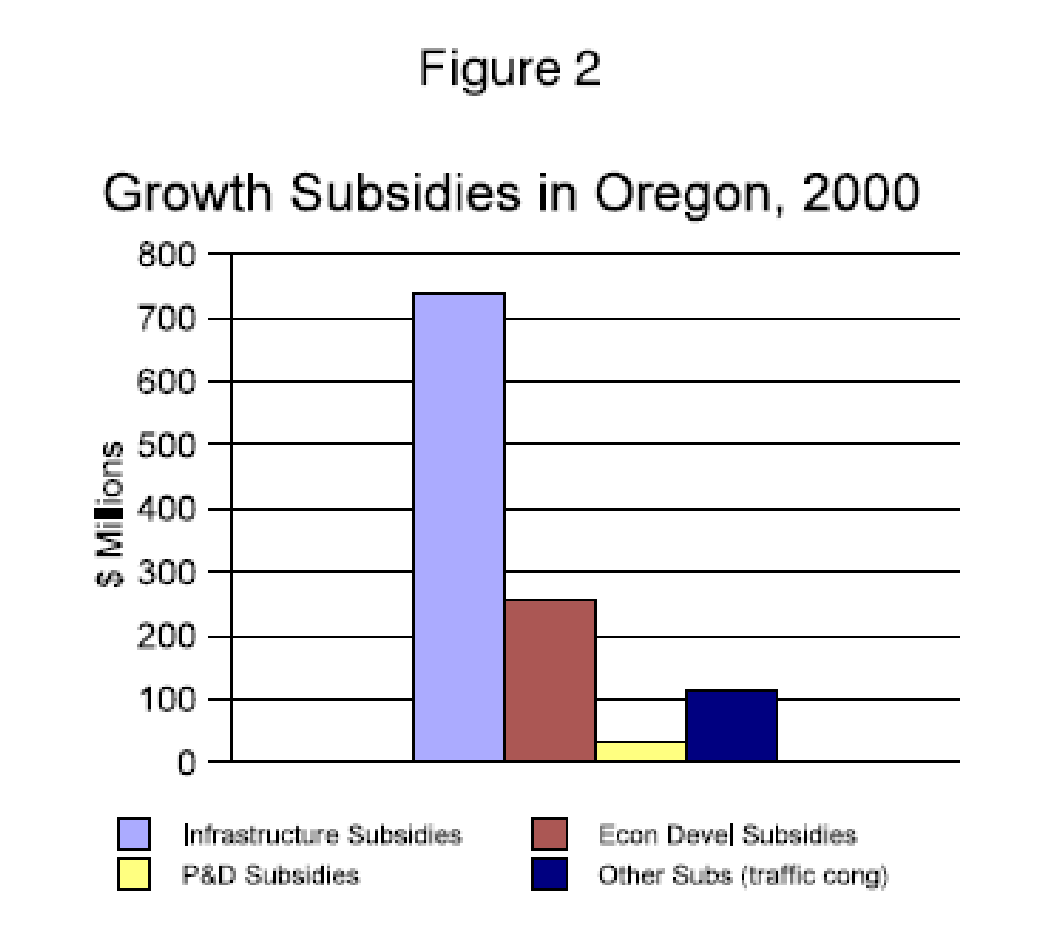- Infrastructures Subsidies
- Economic Development Subsidies
- Subsidized Planning and Development Services
- Other Growth Subsidies (including traffic congestion costs and unmet infrastructure needs)
| Home | Chapters | Programs | Contact |
 |
|
||||||
|
||||||
|
Assessment of Statewide Growth Subsidies in Oregon
Note: The executive summary of the report is reprinted below. To download a pdf of the either the executive summary or the full report, click here. Executive SummaryThe goal of this trail-breaking research effort was to develop a reasonable estimate of the extent to which growth is being subsidized in Oregon. This study is the first effort we know of to quantify all the growth-inducing public policies in any state of the US. While it was an ambitious project, it was approached from a realistic perspective. This project was not intended to produce the definitive report on growth subsidies, but rather to conduct an initial inquiry into the general nature and extent of these subsidies. In doing so, it is hoped that more research and reporting will follow. The focus of this study was on subsidies to urban growth. Urban growth represents both local population increase and land development or growth of the built environment. Economic growth is a related, but different phenomenon that is not included in this definition. The state and local growth-subsidizing programs reported here were selected from among hundreds of candidates. Some program costs had to be left out of the total because they could not be reasonably determined or estimated within the scope of this research effort. Wherever estimates were made or, uncertainty existed, we chose the middle or lower end of the cost range. Our final tally of costs is a conservative one and tends to understate the magnitude of growth subsidies. This study focused only on state and local government spending in Oregon. No federal funds were included. As noted in the report, we subsidize growth in many other ways that are not among the local government expenditures reported here. These subsidies include environmental and social impacts that affect local quality of life and increase the cost of living. Such costs are borne by all residents and businesses of the state. The extent to which the public costs are offset by benefits from growth is the topic of a great deal of speculation and represents an opportunity for further research. Methodology Establishing the definition of a growth subsidy was an important part of this project. While to some extent the definition may seem intuitive, it was a challenge to put it in the clear and unambiguous terms necessary for this study. As explained in the Report, a two-part definition was necessary to address the different types of subsidies identified. Part 1: A "growth subsidy" is a net economic benefit conveyed by state or local government directly to a private business entity which acts primarily to encourage and stimulate urban growth Part 2: A growth subsidy occurs when a broad base of taxpayers or utility ratepayers pays for services or investments which are conveyed primarily to the beneficiaries of new urban growth. A thorough literature review was performed to determine what, if any, similar work had been done. Most of the work identified was related to economic growth and development. The size of this large body of research and literature was narrowed considerably by our focus on subsidization. The results are summarized in the report. Research for this report was made more challenging by the lack of any standard reporting of growth-related costs and expenditures by local governments. While most local governments can readily calculate the new tax revenues resulting from development, few keep track of the costs. For example, the Oregon Department of Transportation spends over a billion dollars every year, but their Comprehensive Annual Financial Report for FY 2000 fails to provide any information that can be used to assess growth-related costs. To compound the challenge, fiscal reporting by some state agencies was abysmal and we were often obliged to rely on agency staff to make determinations as to the amount of various budget lines. All growth subsidies examined in this report were evaluated for the year 2000 (the most recent period for which data was available). Most visible among these subsidies are economic development programs that offer incentives to lure new businesses. But there are many other hidden subsidies that also stimulate growth. As described in more detail below, this study examined the following main categories of subsidies:
Findings Infrastructure Subsidies Infrastructure subsidies proved to be the biggest ticket item in the growth subsidies basket, amounting to $738 million in 2000. This figure represents the net infrastructure subsidy of new growth by established residents and businesses. Payments of development impact fees (system development charges) have been deducted to establish the net amount above. The capital costs of building the infrastructure to serve new development (schools, roads, sewage treatment, fire stations, libraries, etc.) is typically the highest net cost of growth to local governments and taxpayers. A recent survey shows that 73% of Portland Metro Area residents want new growth to pay for all, or more, of its own way.1 Clearly there is an opportunity for public policy improvement in this regard. Economic Development Subsidies Economic development (ED) growth subsidies were divided into five categories: Tax incentives for business development (property and income tax abatements); tax incentives for housing construction; statewide business finance programs; statewide ED expenditure programs; and local ED programs. The largest single growth subsidy program under the ED category is a local ED program known as an Urban Renewal District or Tax Increment Financing District. Fifty-eight districts managed by 40 local agencies statewide spent a total of $84 million in FY 2000. Not surprisingly, the next two largest subsidies are the Enterprise Zone ($33 million) and the Strategic Investment Program ($24 million), both included under the business tax incentives category. These three programs account for over half of the ED growth subsidies, which totaled $257 million for FY 2000. Subsidized Planning and Development Services Based on a representative sampling of Oregon cities and counties, most are charging developers far less than the full cost of processing land use applications, development proposals and building permits. Most of the traditional planning work performed by cities and counties is planning for the accommodation of future growth. To the extent that this work primarily or exclusively benefits new growth and development, it constitutes a growth subsidy. However, to the extent that this work achieves important public goals and primarily provides broad public benefits, the cost would not be counted as a subsidy. Department budgets for planning and development services were compared with fees collected. The City of Eugene, for example, subsidizes 29% of the cost of construction permits and 91% of the cost of planning and land use applications, for a total FY 2000 subsidy of $3,147,152. Based on a sampling of local governments and costs for state planning programs, the total statewide growth subsidy for planning and development services is estimated to be about $33 million. Other Growth Subsidies A number of other growth subsidies were considered in this study, including unmet infrastructure needs (primarily needed schools and roads), measurable social costs, and land use windfalls. The Texas Transportation Institute's 2001 Urban Mobility Report indicates that Oregon's three largest urban areas (Portland, Salem and Eugene-Springfield) built only a fraction (0% to 41%) of the needed transportation infrastructure over the most recent 1994 to 1999 period. The cost to build this needed infrastructure is unknown, but is certainly in the billions of dollars. The result is increased social costs in the form of traffic congestion and delays. The cost of traffic congestion estimated by the TTI, using fuel and time-value costs, was about a billion dollars per year ($995 million). While most of this cost could be considered a growth subsidy, this study conservatively counted only the cost of the congestion increase occurring in 1999 (the most recent year available) of $115 million. 
The Confederation of Oregon School Administrators surveyed Oregon's school districts in 1998 to determine their need for additional classroom space. The COSA survey identified a need for 2,280 new classrooms statewide. The estimated cost of providing these classrooms was $672 million. According to COSA, this is the most recent cost estimate available and no other organization in the state has prepared this type of information. A COSA official estimates that this figure is still in the same ballpark today, but has likely increased somewhat. This cost represents a need that has accumulated over many years, so it is not possible to determine the amount attributed to growth in any particular year. As a result, no estimate of the 2000 cost of unbuilt, needed school facilities was included here. Summary of Statewide Growth Subsidies The statewide growth subsidies evaluated in this report total $1.14 billion for the year 2000. This figure includes only state and local government spending and does not include any federal funds. It is a conservative estimate, since not all of the subsidies could be reasonably determined and since our estimates tended to err on the low side. Table 1 (below) provides a summary of the major subsidy categories and Figure 2 provides a graphic representation of the data. The largest subsidy is the provision of infrastructure to serve new development at three quarters of a billion dollars, or about two thirds (65%) of all subsidies. The second largest growth subsidy is economic development at $257 million, or 22% of all subsidies. Traffic congestion ranks third at $115 million. Among such sizable expenses, subsidized planning and development services seems like a minor cost at only $33 million. While this is not a complete picture of growth subsidies in Oregon, it is the best estimate available to date. The cost of this subsidy is paid primarily by OregonŐs taxpayers. The total subsidy estimate is a conservative figure, since some costs were not available. The subsidy estimate does not include either unmet (unfunded and unbuilt) infrastructure needs or many of the environmental and social costs of growth which impact public health and quality of life. In addition to the subsidies reported here, a number of other growth-related costs have been identified. They include:


Conclusions It is apparent that growth is being heavily subsidized in communities throughout the state. At a cost of $1.14 billion, this growth subsidy is equivalent to an annual per-capita cost of $334 for all Oregonians. Based on an estimated state population increase of 63,800 in 2000, the growth subsidy amounts to about $18,000 per new resident of the state. For comparison purposes, the total state general fund revenues from taxes for the same period (FY 2000) was $4.88 billion. The total amount of this subsidy is substantial and comes at the expense of taxpayers and other public programs and services provided by state and local governments. This is especially significant when considering the severe budget shortfalls the state is experiencing and the unmet needs of public schools, health care, social services, road maintenance and other basic services. Not only is growth subsidization a heavy burden for Oregon's taxpayers, but it is stimulating urban growth that most Oregonians have indicated they don't want. Public opinion surveys clearly show that Oregonians are not enamored with growth. A 1999 statewide survey found that 95% of respondents think Oregon's population is either too big or just right.2 Only 2% prefer it bigger. Surveys from two major metropolitan areas in Oregon show that most residents think their area is growing too quickly and Portland Area residents indicate they want local government to try to slow it down.3 There is little or no indication that the general public wishes to have their tax dollars spent subsidizing growth. Local governments and public officials who believe otherwise, should survey their local residents on the matter. They should refer the question of growth subsidies to the voters to confirm that these growth-inducing expenditures truly enjoy the strong public support that should accompany such a considerable use of public funds.
These subsidies are distorting business and land development markets and inducing growth that is generating more costs for Oregon's taxpayers and impacting communities across the state. While we have no evidence that local governments act to hide growth-related costs in their budgets, very little effort has been made to break out this major expense category from other services the city, county or state provides. Local governments would greatly improve their accountability if they regularly audited their budgets to determine what their growth-related costs are, and report how these costs are being funded. The fact that these subsidies pass largely unnoticed by the public, contributes to their proliferation. Lack of awareness of extent and magnitude of growth subsidies may be the main reason why they continue to be tolerated in Oregon. Those astute folks who do have some inkling of the existence of these subsidies are nonetheless unable to quantify the extent or magnitude of the phenomenon and may be inclined to think it a small matter. This report shows that growth subsidization is, in fact, a very substantial matter. Better information, awareness and understanding of growth subsidization should result in wiser growth policies and better decisions about the use of public funds to induce local growth. While the issue of growth subsidization has largely been a sleeper, it is about to wake up. Contrary to the thinking that growth subsidization may be a small matter, this report clearly shows that the costs are a heavy burden on the state's taxpayers. Growth subsidization depletes funds needed to maintain the state's existing infrastructure and contributes to the budget shortfalls the state is experiencing. Due to its high cost and controversial nature, continued growth subsidization should be among the top public policy issues in the state. Footnotes 1. 2001 Metro Public Opinion Study by Davis and Hibbitts, Inc., May 2001. When asked who should pay the cost of growth, 40% felt developers and new home buyers should pay all of costs associated with infrastructure, 33% felt new growth should pay a greater share, and 21% felt that the costs should be shared equally (6% don't know). 2. 1999 Oregon Annual Social Indicators Survey (OASIS) by the University of Oregon Survey Research Laboratory. The survey was conducted from the middle of November to early December 1999 and asked opinions from a random sample of 420 Oregon residents over the age of 18. The survey results accurately represent the opinions of Oregonians with a maximum error of plus or minus 4.8%. Responses to the question, "Oregon's population is..." were: about the right size - 65.4%; too large - 29.3%; too small - 2.4%; don't know/no answer - 2.9%. 3. 2001 Metro Public Opinion Study by Davis and Hibbitts, Inc., May 2001, showed that 54% of respondents think Metro and their local governments "ought to try to slow growth down." City of Eugene Community Survey (Conducted January 5-19, 1999 for the City of Eugene by Advanced Marketing Research.) asked "Do you believe population growth and development in Eugene during the past 10 years has been too fast, too slow, or just about right? Responses: Too fast - 56%; Just about right - 37%; Too slow - 3%; Don't know - 5%. For Alternatives to Growth Oregon by Eben Fodor, Fodor and Associates
|
|
|||||||||||||